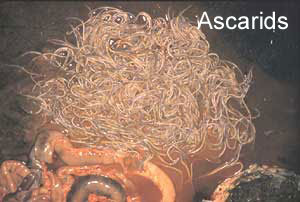Internal parasites are small organisms that live a portion of their life cycle in a host animal–in this case, the horse. They live in internal organs, body cavities, and tissues while gaining their nutritive source by feeding on the host animal. The horse is affected by many different species of parasites. The nature and extent of damage varies with the parasite.
Parasite infestation causes loss of nutrients or blood from the host, resulting in serious medical problems. Horses heavily burdened with parasites will have a loss of condition due to a depletion of nutrients and blood, decreased growth, and reduced reproductive and athletic performance.

Numerous internal parasites infect horses, but there are only a few that commonly cause significant health problems. To establish an effective parasite control program, it is important to first understand the life cycle of parasites. Successful prevention and control programs are effective because they interrupt the life cycle of parasites. In some areas of the country, the primary class of internal parasites that cause health problems for horses are nematodes, such as large and small strongyles, ascarids, and tapeworms. Other internal parasites perhaps of lesser significance, such as pinworms and botfly larvae, are also often considered when designing a parasite control program.
Ascarids, Parascaris equorum, the horse roundworm, is a very large (females may be up to 15 inches long), yellowish white parasite that may pass out in the feces of foals and young horses. Typically, adult horses develop an immunity to this parasite; therefore, roundworms primarily infect young horses less than 2 years of age.

The life cycle of the roundworm starts when the susceptible horse consumes grass, feed, or water contaminated with the infective eggs. The eggs hatch larvae that burrow into the small intestines, migrating through veins to the liver, heart, and eventually the lungs. After migrating in the air spaces of the lungs, the parasite larvae are coughed up and swallowed. The roundworm larvae are returned to the small intestine, where they mature to egg-producing adults, completing the life cycle. The life cycle takes about three months.
Physical damage, such as inflammation and scarring of liver and lung tissue, occur in the horse during migration. Adult roundworms can cause physical damage due to intestinal blockage or intestinal rupture. The damage ranges from mild digestive upset and lower feed absorption to severe colic.
Clinical signs of ascarid infection may include unthriftiness, potbelly, rough hair coat, and slow growth. Some young horses develop nasal discharge accompanied by a cough as a result of larvae migration.
Craig Wood, University of Kentucky


